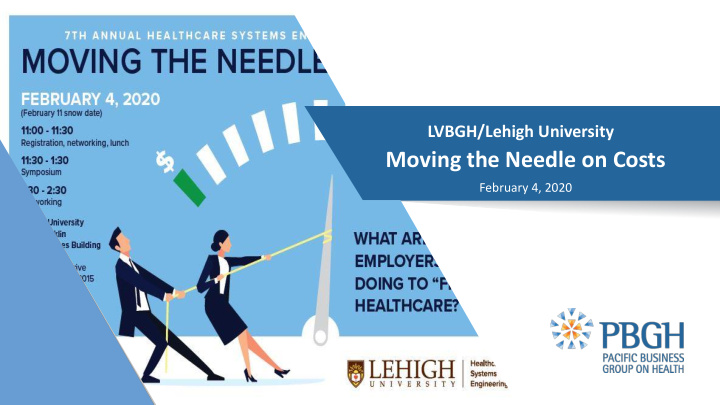



LVBGH/Lehigh University Moving the Needle on Costs February 4, 2020
Pacific Business Purchasing Value • Employers Center of Excellence (ECEN) • Purchaser Value Network (PVN) Group on Health • Maternity Payment Reform • Meaningful Measures/Common ACO Measures • Accountable Pharmacy • Low Value Care • Mental health/Primary Care integration • Benefit design best practices Functional Markets • Influence CMS Policy • Health Care Payment Learning and Action Network (HCPLAN) • Health Care Transformation Task Force (HCTTF) • Antitrust advocacy PBGH Mission : • Drug Pricing Policy • Measurement/transparency To be a change agent creating increased value in the healthcare system through purchaser Advanced Primary Care (Care Redesign) • Intensive Outpatient Care Program (IOCP/AICU) collaboration, innovation and • Practice Transformation action, and through the spread of • California Quality Collaborative (CQC) best practices • Maternity Transformation • Patient Reported Outcomes 2 • Measurement/transparency
Agents for Change 3 PBGH Members - Partial List
What MUST we solve for? 4 Quality and Measurement Waste Misaligned Incentives Poor Patient Experience High Prices (Consolidation)
5 The good news: th there is is lo low hanging fr fruit. The bad news: one person’s “low fruit” is another person’s profi fits.
6 Agenda • Drugs ➢ Waste Free Formulary ➢ Biosimilars • Centers of Excellence • Integrated Delivery Systems (IDS) and TCOC contracts ➢ Low Value Care ➢ Everything Else ➢ Pulling it together: PBGH’s Health Plan Playbook
7 The PBM Business Model is a problem
PBM Revenue Streams are an intermingled mess…that you 8 can’t see through the sauce! • Rebate negotiations with pharma will impact formulary design and PBM revenues • Non “rebate” revenue from pharma also impact formulary placement • Rebates and fees associated with one drug will often be connected to, or “bundled” with other drugs • Rebate negotiations are impacted by pre-authorization protocol • Pre-authorization can impact number of scripts, and the drugs selected, all of which impacts PBM bottom lines • PBM collects UM fees from clients and utilizes pharma- supplied UM services, for which they might also get paid. • PBMs pay pharmacies less than they charge employers (spread) • PBM management of generic definition, AWP source, and AWP date will embellish revenues • Pharmacy relationships will impact DIR and other fees • Pharmacies might be owned by PBM • Rebate “pass through” for jumbo employers will increase • Mail order might imply more fees for packaging/labeling market share (and rebate retention) for smaller clients drugs • ETC.!!!! • PBMs will aggregate rebates for a “wholesaler” market
Managing a formulary pays off 9 1.Is there substantial waste on the formularies of large, self-insured employers? 2.Would doctors prescribe to a common, waste-free formulary? 3.Would employers adopt a common waste-free formulary?
PBGH Waste Free Formulary Project 10 • 15 Data Donors submitted data (4 ESI, 8 CVS, 3 Optum) • 2,543,907 claims evaluated of which 6% were wasteful, consisting of 868 different drugs • Data was limited, assumptions were conservative ➢ No controversial drugs (.01% specialty) ➢ Only considered if excluding the drug saved > 25% ➢ Savings had to apply across formularies, i.e. specific formulary “deals” were excluded ➢ Case study- based assumptions about patients’ behavior ➢ Savings were 11% less than comparative case studies due to conservative assumptions • Estimated savings of this data set was $63.3 million • Represented 2.8% to 24% of total PBM spend (for 9 data donors for whom we knew total spend. 10-24% for 7 of the 9. Two of the 9 had already begun managing their formulary.
11 3. Will employers remove waste? http://www.pbgh.org/news-and-publications/pbgh-in-the- news/539-save-4-25-off-your-pbm-spend
12 Biosimilars = Specialty dru rugs manufactured using same processes as th their “reference drugs” wit ith NO clin linical dif ifference
Patent “Thicket” 13 26 Approved Biosimilars -12 Launched Biosimilars = 14 Tied up in a Patent Thicket
Problem YOU Can Solve. 14 12 biosimilars launched. Uptake slow. Health plan /PBM Buy and Bill Rebates As EASY as 1-2-3 1. Ask your health plan to report on the opportunity for you to save if biosimilars were used 2. Ask your health plan their coverage policies for all biosimilars 3. Talk with your providers about why they are not using biosimilars
15 The Building Blocks of a COE Continuous Facilities and High Quality Quality Surgeons Providers Improvement Qualified Prospective Meaningful Bundled Measurement Payments and PROMS Benefit Design High Touch Incentive Concierge/ (consider a Navigation mandate)
Integrated Care Paid for Differently (APMs; NOT FFS!)
17 IDS and the hope for Low Value Healthcare • Pre-authorization can impact much wasteful spending but are too blunt/disruptive ➢ PA programs have substantial “Member Experience” risk. Once patients hear doctors order/prescribe an intervention….from their perspective, they need it! ➢ Therefore, purchasers want/need providers (doctors) to be the solution! • Plans’ attributed or opt -in value-based programs that reward management of total cost of care have not had tremendous impact…but….moving AWAY from FFS will reduce waste. • Consumer education is great but not particularly effective, e.g. Choosing Wisely • Benefit design can/should play a role, i.e. steerage to higher performing networks.
Recommend
More recommend